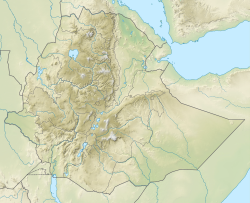Daga (Insel)
| Daga ደጋ | ||
|---|---|---|
 | ||
| Gewässer | Tanasee | |
| Geographische Lage | 11° 53′ 38″ N, 37° 18′ 44″ O | |
| ||
| Länge | 1,5 km | |
| Breite | 1,1 km | |
| Fläche | 50 ha | |
| Höchste Erhebung | 1930 m | |
| Einwohner | 200 400 Einw./km² | |
Daga (amharisch ደጋ ደሴት Dägä Däset) ist eine Insel im Süden des Tanasees in Äthiopien, nur einen knappen Kilometer südöstlich der sehr viel größeren Insel Dek gelegen. Die 0,5 km² große Insel erreicht an ihrem höchsten Punkt 100 m über dem Seespiegel. Auf der für Frauen nicht zugänglichen Insel leben etwa 200 Mönche in dem Kloster Daga Estifanos („St. Stefan von Daga“), die auch das Halten von Nutztieren ablehnen.[1] In dem Kloster sind die Gebeine mehrerer äthiopischer Herrscher aufgebahrt. Unter anderem finden sich hier die, teilweise mumifizierten Überreste, von Yekuno Amlak, David I., Zara Yaqob, Za Dengel, Fasilides und Bakaffa.
Nachweise
- ↑ R.E. Cheesman, "Lake Tana and Its Islands", Geographical Journal, 85 (1935), p. 496
Weblinks
- Informationen über das Kloster (engl.)
Auf dieser Seite verwendete Medien
(c) Karte: NordNordWest, Lizenz: Creative Commons by-sa-3.0 de
Positionskarte von Äthiopien
An astronaut aboard the International Space Station took this photograph of Dek and Daga Islands in Lake Tana, Ethiopia. Both islands are volcanic in origin, as is the lake itself.
Situated in the Amhara Region of the Ethiopian Highlands, Lake Tana is the largest lake in Ethiopia and acts as the headwaters of the Blue Nile River. Dek Island—at 7 kilometers or 4.4 miles from north to south—is the largest island in Lake Tana. The murky green color of the water results from algal blooms, which that live on nutrients supplied from fertilizer fields, wastewater, and other sources of runoff that create nutrient pollution.
The dark green areas in the photo are patches of forest, while the lighter-toned and darker, salmon-colored patches are agricultural fields, which cover 70 percent of Dek Island. It is a prime area for farming because of high-quality volcanic soils, as well as heavy rains due to its location in the Intertropical Convergence Zone (ITCZ). Some of the more common crops are corn and millet, which are mostly consumed by the islanders. Coffee and mangos are the economic mainstays and are shipped to markets on the mainland.
Both islands are home to monasteries of the Coptic Church, most famously Narga Selassie on Dek Island and Dega Estefanos on Dega Island. For hundreds of years, the islands have helped protect the monasteries during times of war. Dega Estefanos is the resting place of mummified emperors who ruled Ethiopia (once known as Abyssinia) centuries ago.
This long-lens image illustrates the level of detail possible from a handheld digital camera shooting from the space station: the numerous white specks are the reflective tin roofs of houses and buildings.

